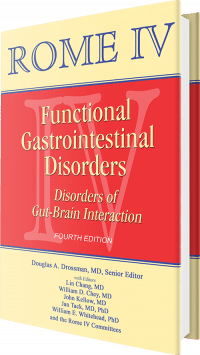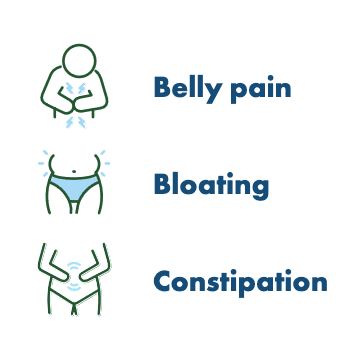Reference List
Rome IV Aims to Improve Outcomes for Patients with Functional GI Disorders like IBS
ROME IV represents the marked and exciting expansion in the science of functional gastrointestinal disorders (FGIDs), which has further improved our understanding of FGIDs like irritable bowel syndrome, chronic constipation and functional dyspepsia, and resulted in more effective treatment options. Since the publication of Rome III in 2006 this evolution of our scientific understanding of FGIDs has grown immensely.

Rome’s Pivotal Role
The Rome Foundation continues to advance knowledge in the field with revisions of the Rome Criteria every 6-10 years. With the release of Rome I, which began the classification system and diagnostic criteria for the FGIDs, clinicians also now have updates based on the latest science that includes a redefinition of FGIDs and diagnostic criteria, addition of newly recognized disorders, and major changes in criteria for existing disorders(1).
FGIDs Redefined
The definition of FGIDs changed with Rome III shifting from absence of structural disease to a more appropriate disorder of GI functioning. Rome IV revised and expanded upon this concept with an agreed-upon term to replace FGIDs when possible: Disorders of gut-brain interaction.
This new term also provides a more meaningful scientific understanding of these disorders, which are classified by gastrointestinal symptoms related to any combination of:
- Motility disturbance
- Visceral hypersensitivity
- Altered mucosal and immune function
- Altered gut microbiota
- Altered central nervous system (CNS) processing

Evolved Understanding
This definition better matches our evolving understanding of multiple pathophysiological processes that, in part or together, determine the symptom features that characterize the Rome classification of disorders. We are confident that clinicians, academicians, regulatory agencies, the pharmaceutical industry, and patients can more easily understand and accept this revised definition.
New diagnoses with known causes
Rome IV has also added new diagnoses with known etiologies under Rome IV. These include:
- Reflux hypersensitivity syndrome (esophageal disorders chapter) where there is heartburn but which is associated with normal physiological degrees of reflux
- Cannabinoid hyperemesis (gastroduodenal disorder chapter), episodes of vomiting like cyclic vomiting syndrome caused by cannabis and which resolves when it is discontinued
- Narcotic bowel syndrome (Centrally Mediated Disorders of Gastrointestinal Pain chapter) which is centrally mediated hyperalgesia from opioids
- Opioid-induced constipation (Bowel disorders chapter) which relates to the peripheral effects of opioids on producing constipation
New Chapters Highlight Evolved Knowledge
Our growing understanding of the following disorders is represented in several new chapters:
- Intestinal Microenvironment and the Functional Gastrointestinal Disorders combines knowledge of the microbiome, food, and nutrition to improve understanding of the luminal aspects of GI function.
- Pharmacological, Pharmacokinetic, and Pharmacogenomic Aspects of Functional Gastrointestinal Disorders (previously titled Pharmacological and Pharmacokinetic Aspects of Functional GI Disorders) includes the role of genetics in the clinical response to pharmaceutical treatments.
- Gender, Age, Society, Culture and the Patient’s Perspective has been split into two articles to reflect the rapid growth of knowledge in these areas: Age, Gender, Women’s Health, and the Patient, and Multicultural Aspects of Functional Gastrointestinal Disorders.
- Biopsychosocial Aspects of Functional Gastrointestinal Disorders (previously called Psychosocial Aspects of Functional Gastrointestinal Disorders) reflects the multi-determined nature of gastrointestinal symptoms and disorders related to social, psychological and biological processes.
- Functional Abdominal Pain Syndrome described in Rome III is now called Centrally Mediated Disorders of Gastrointestinal Pain in Rome IV to reflect the predominant CNS contribution to the symptoms.
Sphincter of Oddi Criteria Revised
Recommendations to perform biliary sphincterotomy based on clinical criteria (biliary dilatation and increased liver chemistries or increased pancreatic enzyme levels) for presumed sphincter of Oddi biliary type pain has not had convincing supportive evidence. Thus, balancing the benefits of symptomatic relief with the potential risks of pancreatitis, bleeding, and perforation has been challenging, and the Rome III criteria for them were not particularly helpful in providing proper guidance. With recent evidence that debunks the value of sphincterotomy for type III SOD, the chapter committee has reclassified these disorders, now providing a more rational treatment algorithm. The previous type III SOD categorization of the Milwaukee classification has been removed. SOD type I is now considered sphincter of oddi stenosis and is not in the classification system. Similarly, as noted SOD type III is now considered functional GI rather than biliary pain
B3a Chronic Nausea Vomiting Syndrome – New Diagnosis
Due to a lack of evidence delineating different diagnostic approaches and management of nausea compared with vomiting, and the clinical observation that these two symptoms commonly are associated, the new diagnosis B3a Chronic Nausea Vomiting Syndrome combines the previous Rome III entities Chronic Idiopathic Nausea and Functional Vomiting. Although we recognize patients may present only with nausea, the clinical approach to diagnosis and management remains the same.
Discomfort Removed from IBS Criteria; Now Exists on Spectrum Pain, Stool Consistency
Some major changes that are likely to affect a large portion of patients include removal of the term “discomfort” from IBS criteria, and the existence of functional bowel disorders on a spectrum of symptom presentations that relate to stool consistency and the degree of pain. Figure 1 (see below) indicates how the functional bowel disorders exist on a continuum as related to the degree of pain or the consistency of stool. Thus, as shown on the left, when there is little or no pain, patients may have functional diarrhea or constipation, but in patients with greater degrees of pain patients are classified as IBS, C or D respectively which in turn depends on the stool consistency. This is based on evidence that patients often migrate across categories over time.
IBS Subtypes ID Change Accounts for Normal Stool Periods
Finally, there is also a change in how to identify the IBS subtypes. Previously, Rome III classification for IBS subtypes required that the proportion of total stools using the Bristol Stool Form Scale be used to classify IBS with predominant diarrhea (>25% loose/watery, <25% hard/lumpy), IBS with predominant constipation (>25% hard/lumpy, <25% loose/watery), mixed-type IBS (>25% loose/watery, >25% hard/lumpy), and IBS unclassified (<25% loose/watery, <25% hard/lumpy).
However, because patients can have large periods of time with normal stool consistency, a majority of them have unclassified IBS subtype relative to the other groups. Based on this observation and the results of a Rome Foundation Normative Symptom Study, the criteria have been changed and relate to the proportion of days with symptomatic stools (i.e., loose/watery and hard/lumpy) rather than all stools (including normal ones). This change markedly reduces the number of patients in the unclassified group.
Novel Education Materials Now Available
One of the most exciting features for Rome IV involve the development of novel educational materials in addition to the Rome IV book.
This includes 5 books:
- Rome IV Diagnostic Algorithms
- Rome IV Multidimensional Clinical Profile (MDCP)
- Rome IV for Primary Care and Non-GI Clinicians
- Rome IV Pediatric Functional GI Disorders
- Rome IV Validated Adult and Pediatric Questionnaires
In addition, we are releasing the Rome IV Interactive Clinical Decision Toolkit, an intelligent software program that incorporates the knowledge from the diagnostic algorithms and the MDCP. For further information on these materials please visit the Rome Foundation website.
Douglas A. Drossman MD
Dr. Drossman is the Founder and President of the Rome Foundation, Member of the Board of Directors and Chair of the Scientific Advisory Board of the International Foundation for Functional GI Disorders (IFFGD). He is President, Drossman Center for the Education and Practice of Biopsychosocial Care LLC; President, Drossman Consulting LLC; Adjunct Professor of Medicine and Psychiatry, University of North Carolina School of Medicine; and Former Co-Director, UNC Center for Functional GI and Motility Disorders. He serves on the Gastro Girl advisory team.
(1) Drossman DA. Functional Gastrointestinal Disorders: History, Pathophysiology, Clinical Features and Rome IV. Gastroenterol 2016;148(6):1262-79.
Figures
Figure 1. Association of stool consistency and degree of pain in defining functional bowel disorders. It is now recognized that patients with functional bowel symptoms will shift in their diagnostic categories over time as demonstrated by this figure.

Listen to our
latest Podcast!








